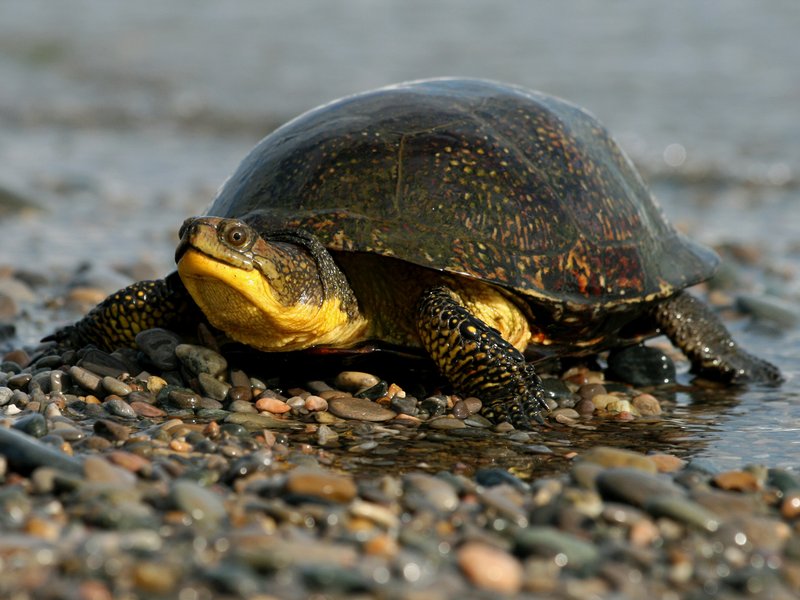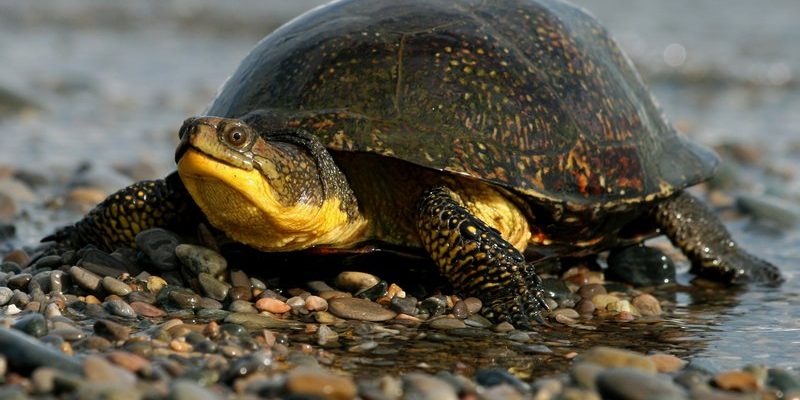
Have you ever seen a turtle with a bright yellow chin? That’s the Blanding’s Turtle, a charming creature that looks like it stepped out of a nature documentary. This turtle has a unique combination of a domed shell and a cheerful disposition, which makes it a favorite among turtle enthusiasts. But there’s more to this delightful reptile than just its appearance.
The Blanding’s Turtle is not just an ordinary turtle; it’s a species that’s been around for millions of years! Its charm lies in its ability to thrive in various habitats, ranging from wetlands to ponds. However, despite its resilience, this species is facing challenges due to habitat loss and climate change. Let’s dive deeper into the fascinating world of the Blanding’s Turtle, and learn why preserving its habitat is crucial.
Physical Characteristics
The Blanding’s Turtle is easily recognizable due to its distinctive features. It has a smooth, dark carapace which can reach lengths of up to 9 to 10 inches in adults. This shell is both sturdy and sleek, allowing the turtle to glide through water with grace. Its most striking characteristic, however, is its bright yellow or cream-colored throat and chin, which can truly brighten up a dull day.
In addition to its yellow chin, the Blanding’s Turtle possesses a long neck that helps it navigate its environment. You might even say this turtle is a bit like a giraffe of the turtle world, reaching out to explore its surroundings. Its limbs are strong and webbed, making it an excellent swimmer, but it also has strong legs for walking on land.
One fascinating aspect of the Blanding’s Turtle is its age. These turtles can live for over 70 years in the wild! That’s a big commitment, kind of like adopting a pet turtle but much longer. With such a long lifespan, every Blanding’s Turtle has a wealth of experiences that contribute to its unique personality.
Habitat and Distribution
Blanding’s Turtles prefer freshwater habitats, thriving in marshes, swamps, and shallow lakes. They are most commonly found in the northeastern and north-central regions of the United States and parts of Canada. Imagine them basking on a sunlit rock by a serene pond, or gently swimming through calm waters — that’s their ideal lifestyle.
These turtles tend to choose habitats that are rich in aquatic vegetation, as they rely on these plants for food and shelter. This unique environment not only supports their diet but also provides a safe space for nesting. Unfortunately, the Blanding’s Turtle’s habitat is shrinking due to urban development and agricultural expansion, putting pressure on their populations.
It’s worth noting that these turtles are also quite adaptable. They can travel between ponds and wetlands as they search for food or suitable nesting sites. Their ability to migrate allows them to find the right environment, but it also exposes them to risks like roads and predators. So, while they are resourceful, they still depend on intact habitats for survival.
Diet and Feeding Habits
Blanding’s Turtles are omnivorous, meaning they enjoy a varied diet. They primarily munch on aquatic plants, but they also feast on insects, crustaceans, and small fish. This diversity in their diet is crucial for their health and well-being. It’s almost like a buffet, where they can choose what suits their fancy on any given day!
When feeding, these turtles use their long necks to reach for their favorite snacks. You might see them foraging around the water’s edge or diving below the surface. Imagine a turtle with a chef’s hat, carefully selecting the freshest greens and tasty critters to create a delicious meal. Nutrition is vital for helping them grow and thrive.
Interestingly, Blanding’s Turtles have also been observed engaging in some pretty unique foraging behaviors. They’ve been seen digging in the mud for food, showcasing their resourcefulness. This adaptability is a testament to their survival skills, ensuring they can find sustenance no matter the challenges they face.
Reproduction and Lifecyle
The reproductive cycle of the Blanding’s Turtle is a captivating process. Breeding usually takes place in the spring, when temperatures warm up, and males actively seek out females. Once they find a mate, the female lays approximately 8 to 20 eggs in sandy or loose soil, often near water. Picture a mother turtle carefully tucking her eggs into the ground, ensuring they are safe from predators — it’s a nurturing moment in the wild.
After laying eggs, the mother turtle leaves them to develop on their own. The eggs incubate for about 75 to 90 days, and hatchling turtles emerge around late summer. These tiny turtles are remarkably independent from the start, needing to fend for themselves right after hatching. It’s like a little rite of passage — they must navigate their way to safety while avoiding predators.
As they mature, Blanding’s Turtles undergo various growth stages, eventually reaching sexual maturity around 14 to 20 years of age. This long maturation period is common for their species, which highlights the importance of protecting their habitats. Every Blanding’s Turtle contributes to the ecosystem, and with such a lengthy development process, each individual plays a vital role in ensuring the species’ continuity.
Conservation Status
Sadly, the Blanding’s Turtle is listed as a threatened species in many regions due to habitat loss and fragmentation. Urban development, agriculture, and climate change have all contributed to the decline in their populations. Imagine the frustration of these turtles trying to find a suitable home, only to encounter roads or drained wetlands. It’s a tough world out there for them.
Conservation efforts are underway to help protect this species. Organizations are working to restore their habitats, create wildlife corridors, and raise public awareness about their plight. These initiatives are critical in ensuring that future generations can admire these charming turtles as they bask in the sun.
Community involvement is also vital in conservation efforts. With simple actions like reporting sightings or participating in local clean-up events, you can contribute to the Blanding’s Turtle’s survival. Every little bit helps in this ongoing battle to protect a precious species that has been around for so long.
Interesting Facts
| Fact | Description |
|---|---|
| Colorful Chin | The Blanding’s Turtle has a bright yellow or cream-colored chin that distinguishes it from other turtles. |
| Long Lifespan | These turtles can live for over 70 years, making them one of the longer-living turtle species. |
| Good Swimmers | With strong limbs and a streamlined shell, Blanding’s Turtles are excellent swimmers. |
| Omnivorous Diet | They feed on a mix of aquatic plants, insects, and other small animals, making their diet quite varied. |
| Independent Hatchlings | Baby Blanding’s Turtles are immediately independent upon hatching, needing to fend for themselves. |
FAQ
Where can I find Blanding’s Turtles?
Blanding’s Turtles are found mainly in wetlands and aquatic environments across the northeastern and north-central United States and parts of Canada. If you’re looking to catch a glimpse, consider visiting local marshes, ponds, or lakes where they might be basking on rocks or swimming in the water.
What do Blanding’s Turtles look like?
These turtles have a smooth, dark shell that is somewhat dome-shaped, and they can grow up to 10 inches long. Their most distinctive feature is the bright yellow or cream-colored chin and throat, which contrast beautifully with their dark shell. This makes them particularly eye-catching in the wild.
How do Blanding’s Turtles reproduce?
During spring, male Blanding’s Turtles seek out females for breeding. After mating, the females lay their eggs in sandy or loose soil, usually near water bodies. The eggs incubate for about 75 to 90 days before hatching, and the tiny hatchlings are left to fend for themselves from the get-go.
Why are Blanding’s Turtles threatened?
Their populations have declined primarily due to habitat loss from urban development, agriculture, and climate change. These factors have severely impacted their natural environments, making it difficult for them to find suitable places for nesting and foraging. Conservation efforts are crucial to help protect this species.
What can I do to help Blanding’s Turtles?
You can contribute to their conservation by participating in local clean-up events, avoiding littering in their habitats, and reporting any sightings of these turtles to local wildlife organizations. Spreading awareness about their plight can also encourage others to take action.
How long do Blanding’s Turtles live?
In the wild, Blanding’s Turtles can live for over 70 years. Their long lifespan is one of the reasons why protecting their habitats is so important; every individual plays a valuable role in their ecosystem over many decades.
Do Blanding’s Turtles have any predators?
Yes, like many turtles, Blanding’s Turtles face threats from various predators, including raccoons, opossums, and birds of prey. Their eggs are also at risk from various animals that might dig them up. This is why nesting sites need to be secure, and protecting their habitat is vital.
How do Blanding’s Turtles adapt to their environment?
These turtles are quite resourceful and can travel between different ponds and wetlands in search of food and suitable nesting sites. Their adaptability helps them survive in changing conditions, though they still rely heavily on intact natural habitats.
What is the best way to observe Blanding’s Turtles?
If you’re interested in observing Blanding’s Turtles, visiting their natural habitats during warmer months can be rewarding. You might see them basking on logs or swimming in the water. Just remember to keep a respectful distance and avoid disturbing them, as they are a protected species in many areas.
What role do Blanding’s Turtles play in their ecosystem?
Blanding’s Turtles contribute to their ecosystems by helping to maintain healthy aquatic environments. They play a part in controlling the populations of insects and aquatic plants. In this way, they help balance their habitat, making them important players in the ecological community.

